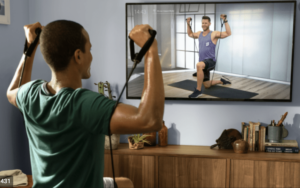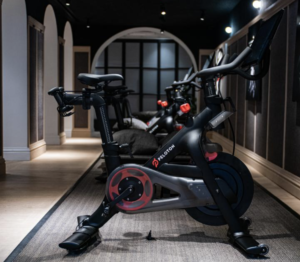 Have you always wanted to learn more about kinesiology tape? Did you wonder how to use it and whether it can be useful in rugby?
Have you always wanted to learn more about kinesiology tape? Did you wonder how to use it and whether it can be useful in rugby?
We have teamed up with d3, founded by former All Black, Craig Dowd, to give you all of the information that you need about kinesiology tape to get you started.
We recommend giving it a try to reduce aches or pains that you may feel after intense training, a match or over a long weekend of rugby like a 7s tournament.
How Does Kinesiology Tape Work?
 Kinesiology tape can be used for both rehab and prehab purposes.
Kinesiology tape can be used for both rehab and prehab purposes.
Essentially the way it works is by increasing blood flow to a particular area of the body, which increases and speeds up healing. It does this by gently stretching the skin away from the muscle and thereby increasing the blood flow.
This can help muscle tightness or bruising and clinical studies have also demonstrated that it can reduce pain.
In particular, common uses for rugby players are to help with knee, calf and shoulder pain but also things like a dead leg.
The kinesiology tape used by d3 (called “K-Tape”) is latex-free and hypoallergenic, meaning that adverse skin reactions are very rare and tape can be worn for days on end.
K-Tape is now used by some of the most competitive rugby teams in the world including the Cantenbury rugby team, the Pumas, Sale Sharks and the Barbarians.
However, the tape has uses beyond the rugby pitch and can be used by athletes in all sports and in a variety of applications.
“I wish the elderly would try the kineselology tape. For arthritis and sore necks, the tape would be really beneficial,” Craig said.
The great news is that you can’t hurt yourself by experimenting with it, so check out the guides below and give it a try!
A roll of tape will cost between £5-10 depending on the brand and length, so it won’t break the bank. If you are still stuck in quarantine, use this time to develop a new skill which will help you when rugby is back in session.
How to Apply Tape
D3 have published a fantastic strapping tutorial guide on how to apply the tape for different parts of the body along with helpful instructional videos focusing on all of the different body parts and issues including shoulder, knee, elbow, ankle, neck, plantar fasciitis, hamstring, wrist, lower back, hand and thumb, calf and many others
The full tutorial can be found here and the full set of instructional videos can be found here. We set out below instructions for knee strapping as an example.
 PREPARATION: Cut two strips of d3 K-tape. #1: Shin bone (Tibia) to thigh (Femur) – 25-35cm approx & #2: across the patella/kneecap – 10-15cm approx. If using d3 adhesive spray, spray the area to be taped lightly and allow the area to get tacky by leaving it for 30 seconds to air dry.
PREPARATION: Cut two strips of d3 K-tape. #1: Shin bone (Tibia) to thigh (Femur) – 25-35cm approx & #2: across the patella/kneecap – 10-15cm approx. If using d3 adhesive spray, spray the area to be taped lightly and allow the area to get tacky by leaving it for 30 seconds to air dry.
1. Ensure that the athlete’s knee is slightly flexed (bent) prior to taping.
2. TAPE STRIP #1: Cut the K-tape to the required length (below the knee to midthigh) allowing for the fact that it will be stretched (longer) by around 10% on application. 25-35cm for an adult is a good general guideline.
3. Tear the ends of the backing tape (but don’t remove them yet) about 10cm from each end of the tape to create the anchor points for the start and end of the taping procedure

4. Remove the backing tape from the first (lower) anchor point and place 5-10 cm below the kneecap (patella) onto the top of the shin bone (Tibia). There should be no stretch on the achor tape.

5. Peel back the long middle part of the backing tape, but leaving the end (top) anchor backing tape in place.
6. Stretch the k-tape 25-50% (personal preference) and place directly over the middle of the kneecap (patella) whilst holding down the starting anchor tape and continue up the middle of the thigh.

7. Remove the backing tape from the second anchor and place down on the skin with no stretch.
8. TAPE STRIP #2: Tear the ends of the two anchor strips and peel away the middle part of the adhesive backing tape to expose the adhesive side. Holding the anchor ends place the centre of the tape directly over the middle of the base of the kneecap (patella) and stretch it 50-90%. Angling the tape up the inside and outside of the lower thigh place onto the skin without creasing the tape.
9. With zero stretch on the anchor strips, remove the backing tape and place both anchors down.

10. Rub all of the applied tape down, with the hand, or the removed backing paper, to help fully activate the glue and increase adhesiveness.
We highly recommend you read the additional tips for applying K-tape can be found here.
About d3
 The company was started in New Zealand in 2010 by former All Black, Craig Dowd, with his business partners Karey Burt and Stephen Burt. The D3 is a reference to three three dads involved (how awesome is that?).
The company was started in New Zealand in 2010 by former All Black, Craig Dowd, with his business partners Karey Burt and Stephen Burt. The D3 is a reference to three three dads involved (how awesome is that?).
The company began by selling tackle pads but quickly moved into the consumables market.
Craig was no stranger to wearing a lot of tape throughout his career and he was committed to producing a good quality product. “Our vision is to fulfill consumer needs for a quality and affordable range of sports tapes,” Craig said.
After 5 years of experimentation and visiting 19 factories around the world, d3 found a tape combination that they were excited to bring to market.
The tape comes in 12 different fun and exciting colours at very affordable prices.
“Consumers clearly appreciate the uniqueness of d3 our quality tape is in funky packaging, with vibrant fashion colours,” Craig said.
“What we love most is that we are making changes to a tired old industry. We are adding a fun and a rebellious side to a medical product,” Craig said.
The company also makes a real effort to work with and sponsor both elite level sponsored athletes as well as more amateur athletes.
“We love the community. We have to buy into the community because we are nothing without them. We look to help top level professionals as well as a person that just wants to be active. If we got asked by struggling schools to help out, if we can help them out, we will,” Craig said.
Recently d3 sponsored the FindRugbyNow Invitational 7s Team’s trip to Barbados by providing players with an essential kit bag of K-Tape in the FRN green & white FRN colours as well as gumshields, water bottles and dry ice. Needless to say, it was very well received by the players and K-Tape was of superb quality.
Look out for our interview with Craig, which will be coming out soon!
Where can I buy K-Tape
 Clubs can order the K-Tape directly from d3 at very competitive rates.
Clubs can order the K-Tape directly from d3 at very competitive rates.
Individuals can also purchase tape from a list of retailers in the UK, New Zealand, Australia, Argentina, and South Africa. A full list of retailers can be found here.
You can also purchase other types off kinesiology tape online or in a variety of sports shops.
More Information
d3 ship internationally and regularly work with rugby clubs to provide orders 3 or 4 times per season, UK. Check out their website here or reach out to them via email on info@d3tape.uk.








 When most people hear the word “Peloton” they think of an expensive black bike with shiny red buttons and that controversial commercial where the husband gifted his wife a Peloton for Christmas.
When most people hear the word “Peloton” they think of an expensive black bike with shiny red buttons and that controversial commercial where the husband gifted his wife a Peloton for Christmas. If the app interests you, Peloton is currently offering a 30 day FREE TRIAL, so why not give it a try? Check it out
If the app interests you, Peloton is currently offering a 30 day FREE TRIAL, so why not give it a try? Check it out 

 This article would not be complete, however, if we did not acknowledge some of the delivery issues that have been plaguing Peloton over the last year. Most of the delivery issues seem to affect U.S. deliveries, however, the UK deliveries have been affected as well.
This article would not be complete, however, if we did not acknowledge some of the delivery issues that have been plaguing Peloton over the last year. Most of the delivery issues seem to affect U.S. deliveries, however, the UK deliveries have been affected as well.







